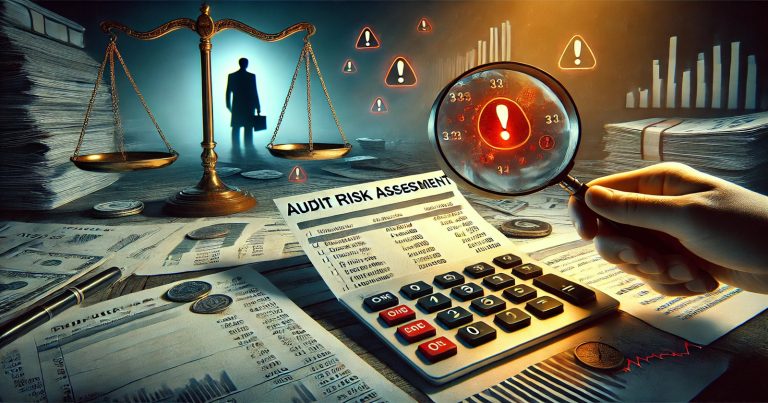Risk assessment is a crucial aspect of an audit, allowing auditors and/or management to identify and evaluate risks across financial statements and business processes. It is a systematic approach to identify misstatements, fraud as well as operational risks. The audit risk assessment process is what allows auditors to look at all the financial data and internal controls to mitigate risk. For example, if an accountant assesses the risk of material misstatement to revenue as significant, they can plan their audit work accordingly to address this risk by doing aging analysis or analytical procedures. Different organization carries different types of risk so various audit risk assessment techniques help to assess the risk. For accuracy and compliance, audit risk assessment in financial statements is essential. Auditors use an audit risk assessment matrix to rank risks in terms of severity and likelihood. Structured Audit Risk Assessment Framework helps organizations follow standardized procedures. Auditors check compliance and accuracy using an audit risk assessment checklist. It enables organizations to minimize financial misconducts and maintain transparency.
What is Audit Risk Assessment?
Audit risk assessment holds strategic importance within the domain of auditing practices.
The practice of Audit risk assessment involves determining and analysing the risks associated with an entity’s financial and operational activities. It enables auditors to identify errors and material misstatements in financial records. This mitigates risks associated with fraud, compliance violations, and accounting errors.
Audit Risk Assessment Types
Let us examine the types of audit risk assessment techniques utilized for financial risk analysis:
- Inherent Risk – The risk that financial statements are incorrect before factoring in controls.
- Control Risk – Risks that the internal controls will not catch the errors.
- Detection Risk – The risk that an auditor doesn’t discover a misstatement.
Why Audit Risk Assessment Matters?
To minimize financial loss and promote transparency, organizations need to conduct audit risk assessment.
- Finding Errors & Fraud In Financials Statements
- Enhance adherence to accounting standards.
- Improve the reliability of financial reports
- Prevent material misstatements.
- Strengthen internal controls.
An audit risk assessment template helps organizations to methodically assess audit risks.
Audit Risk Assessment Process
The process of assessing the risks of audit is a step-by-step mechanism to investigate and manage the risk on the financial statements. The risk assessment process is formalised up to specific timelines, including due dates, so that the audit firm covers all aspects of the audit.
The Audit risk assessment steps are as follows:-
- Assessment Of Risks Risks auditors assess are about financial statements, internal controls, and compliance issues. Audit risk assessment tools are used by companies to gather data and insights.
- Evaluating Risks Auditors utilize an audit risk assessment matrix to evaluate the magnitude of risks.
- Reducing mistakes: NetSuite was born with built-in transaction controls that reduce mistakes by eliminating the need for manual input between systems. Internal audit audit risk assessment ensures that controls work.
- Financial Statements: Assessing Audit Risk in financial statements auditors examine Transactions, Cash Flows and Financial records
Checklist for Audit Risk Assessment
Findings and Recommendations Auditors use an audit risk assessment checklist to document the findings and recommendations. Revising and Updating Risks Organizations need to regularly identify risks; therefore, the assessment must hold true and up to date.
Audit Risk Assessment Factors
The quality of the audit risk assessment depends on various factors:
- Complexity of Financial Transactions — The more complex the transaction, the greater the risk of audit.
- Regulatory Compliance – Non-compliance is costly.
- Business Risks – Audit risks are influenced by various economic and market conditions.
- Quality of Internal Controls – Where control quality is weak levels of risk exposure go up.
How to Identify and Manage Risks?
All organizations apply several different methods of audit risk assessment to recognize and minimize risk. Depending on the type of business and financial structure, one method may be preferred over another.
Qualitative Audit Risk Assessment
This technique utilizes expert opinion to assess risks. Auditors categorize risks as low, medium, or high based on experience and industry knowledge. It enables organizations to prioritize high-risk areas.
Quantitative Audit Risk Assessment
Data analysis is the basis of this method, which quantifies risks. Financial risks are evaluated using statistical and probability models. Financial modeling and predictive analytics — what organizations use to assess risk.
Audit Risk Assessment Based on Control
This approach assesses an organization’s internal controls. They assess whether policies, procedures and security measures mitigate financial exposure.
Substantive Audit Procedures
Auditors perform a process of divedown transaction testing to confirm accuracy. This method involves:
- Verifying account balances to identify errors
- Analytical procedures — comparing financial data over time.
- Confirmations with third parties of transactions.
Relevance to ACCA Syllabus
Relevance to ACCA Syllabus Audit risk assessment is important for the ACCA syllabus because auditors must identify, evaluate, and mitigate risks in financial statements. This is a crucial part of the Audit and Assurance (AA) and the Advanced Audit and Assurance (AAA) papers. Inherent, control and detection risks must be evaluated in the context within ACCA qualified professionals to ensure that audit quality is preserved and international standards are maintained.
Audit Risk Assessment ACCA Questions
Q1: Part of audit risk is made up of which of the following? A) Inherent Risk
B) Business Risk
C) Reputational Risk
D) Operational Risk
Ans: A) Inherent Risk
Q2) What is the key reason for evaluating audit risk? A) To increase audit fees
B) To have an efficient audit plan
C) To ensure the financial viability
D) Grow the company profits
Ans: B) Good audit plan and a efficient audit plan
Q3: In audit, detection risk means the risk that: A) Material misstatements are not detected by auditor
B) Financial statements have mistakes
C) The company commits fraud
D) Controls are not operating effectively
Ans: A) Auditor fails to detect material misstatements
Q4: Which Standards provide guidance on audit risk assessment? A) ISA 315
B) IFRS 9
C) ISA 200
D) IAS 1
Ans: A) ISA 315
Q5: Which of these actions reduces audit risk? A) Performing additional audit procedures
B) Control weaknesses are neglected
C) Reducing sample sizes
D) Placing reliance solely on management representations
Ans: A) Perform additional audit procedures
Relevance to US CMA Syllabus
Importance of Audit risk assessment in the US CMA syllabus: Ensures that management accountants are aware of the financial risk involved in its operations and its internal control system. The Internal Controls and Risk Management part focuses on assessing risks impacting financial integrity and decision-making.
Audit Risk Assessment CMA Questions
Q1: Which of the following risk is associated with material misstatements within financial statement? A) Market Risk
B) Credit Risk
C) Audit Risk
D) Strategic Risk
Ans: C) Audit Risk
Q2. How do internal controls influence audit risk assessment?
A) To raise operational costs
B) To reduce control risk
C) To reduce audit procedures
D) To commit financial statement fraud
Ans: To reduce control risk
Q3: The inherent risk is high if:
A) Transactions are routine
B)Transactions are complex and the numbers are estimated.
C) Strong internal controls
D) Audited annual financial statements
Ans: B) Transactions are not simple and are estimates
Q4: What is the response of an auditor to a high level of audit risk?
A) Reduce audit procedures
B) More widespread sampling and analysis
An auditor should: Wi/P22 C) Rely on management assertions
D) Remove substantive procedures
Ans: (B) Increase sample sizes and testing
Q5: What can help reduce audit risk?
A) Control deficiencies are ignored
B) Appropriate substantive testing
C) Only based on previous audits
D) Overlooking analytical procedures
Ans: B) Evaluating substantive testing
Relevance to US CPA Syllabus
US CPA All the points above relate directly to Audit risk assessment which is an essential part of the types of US CPA syllabus or AUD US CPA syllabus. The CPA candidates must know how to assess risk to perform an audit that meets PCAOB and AICPA standards.
Audit Risk Assessment CPA Questions
Q1: What is the objective of audit risk assessment?
A) To detect fraud
B) Rate management integrity
C) To make sure the audit opinion is correct
D) To restore confidence of investors
Ans: C) To ensure audit opinion is correct
Q2: Control risk is higher when:
A) Internal controls are poorly designed
B) Effectiveness of internal controls
C) A lot of experience in the audit
D) The audit is done yearly
Ans: B) Internal controls have failed
Q3: What type of audit procedure decreased detection risk?
A) Analytical procedures
B) Money laundering
Reducing sample sizes for tests
D) Audit working papers from prior years
Ans: A) Analytical procedures
Q4: What an auditor has to do in the case of high control risk.
A) Reduce substantive testing
B) Greater reliance upon internal controls
C) Do more extensive substantive testing
D) Limit the collection of audit evidence
Ans: C) Carry out further substantive auditing procedures
Q5: Which of the following is a key objective of an auditor during the planning stage of an audit?
A) Tax laws noncompliance identification
B) Understanding the entity and its environment
C) Evaluating marketing approaches
D) Evaluating CEO performance
Ans: B) The entity and its environment
Relevance to CFA Syllabus
The concept of the audit risk assessment is provided importance under the CFA exam, particularly concerning financial reporting and analysis. They must also understand audit risks to assess the reliability of financial statements so they can make informed investment decisions.
Audit Risk Assessment CFA Questions
Q1 What does audit risk mean?
A) The potential for financial loss for the auditor
B) The potential for an incorrect audit opinion
C) The risk of a company not meeting investor expectations
D) The threat of low employee productivity
Ans: B) The risk of giving a mistaken audit opinion
Q2: Why do high audit risk matter to investors? A) It improves reliability of the financial statements
B) It flag financial ambiguities
C) It ensures robust financial results
D) It boosts confidence in the markets
Ans: B) This will raise alarms on financial accuracy
Q3: What are the indicators of audit risk with respect to financial statement analysis? A) Conduct a comparative analysis of CSR reports
B) By looking at past audit opinions and discrepancies in their finances
C) Solely observing stock prices
D) Ignoring financial ratios
Ans: B) Through deciphering previous audit opinions and financial discrepancies
Q4: All the following increases inherent risk in financial statements, EXCEPT: A) So, simple and easy daily transactions
B) Complex financial instruments and estimates
C) Strong internal controls
D) External audits
Ans: B) Complex financial instruments and estimates
Q5: What do you think is the most concern of investors about the audit risk?
A) The cost of audit services
B) Financial statements may be incorrect,
C) The auditor’s salary
D) What marketing strategies the company used
Ans: B) Financial statements may not be a true and fair view


